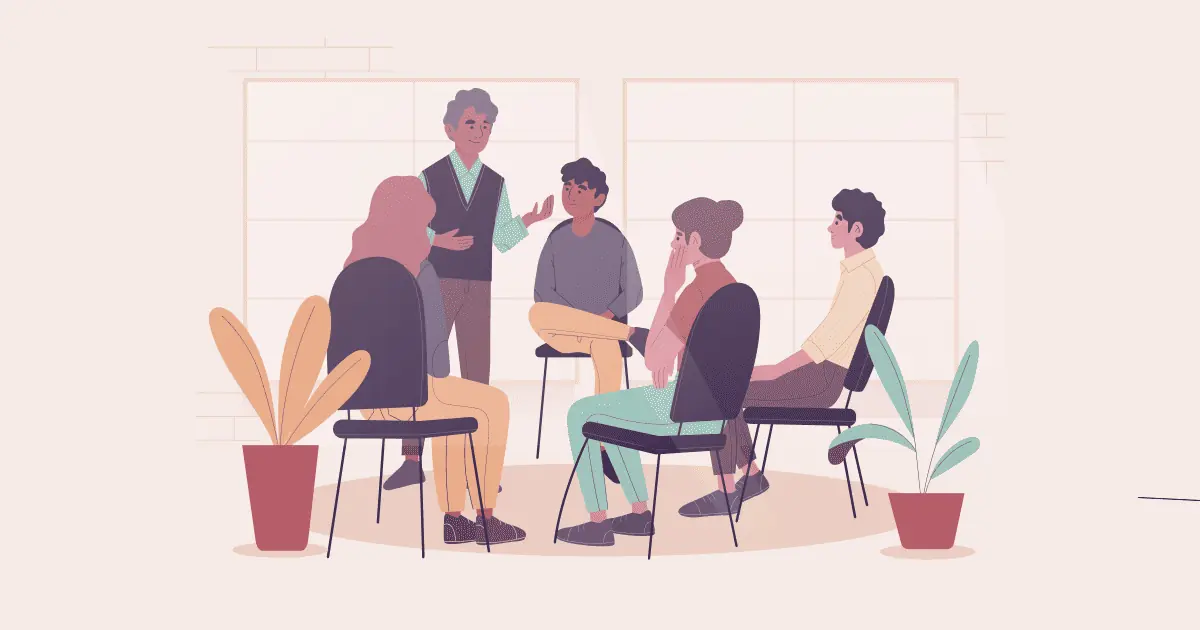Was ist dein Körpersprache während der Präsentation Was sagt über dich aus? Do's und Don'ts! Lass uns die besten Tipps mit AhaSlides lernen!
Was ist also die beste Haltung für eine Präsentation? Kennst du das Problem mit den Händen? Wahrscheinlich nicht, denn das habe ich mir gerade ausgedacht. Aber – wir alle kennen Momente, in denen wir nicht wissen, wohin mit unseren Händen, Beinen oder irgendeinem anderen Körperteil.
Vielleicht haben Sie etwas Fantastisches Eisbrechertadellos Einführungund eine hervorragende Präsentation, aber die Darbietung ist das Wichtigste. Sie wissen nicht, was Sie mit sich anfangen sollen, und es ist vollkommen normal.
Übersicht
| Was ist die Körpersprache der Verlegenheit? | Blick nach unten, Lächelkontrolle, weggedrehte Kopfbewegungen und Gesichtsberührungen |
| Was sind die nonverbalen Zeichen der Scham? | Hängende Schultern, gesenkter Kopf, Blick nach unten, kein Augenkontakt, uneinheitliche Sprache |
| Merkt das Publikum, wenn der Moderator schüchtern ist? | Ja |
| Warum war die Präsentation von Steve Jobs so gut? | Er hat einfach viel geübt und sich dafür interessiert Präsentations-Outfits |

Tipps für besseres Engagement
- Persönlichkeit in einer Präsentation
- Wie drücken Sie sich aus?
- Nutzen Sie Live-Wortwolken or Live-Fragen und Antworten zu Befragen Sie Ihr Publikum einfacher!
- Nutzen Sie Brainstorming-Tool effektiv durch AhaSlides-Ideentafel

Starten Sie in Sekunden.
Erhalten Sie kostenlose Vorlagen für Ihre nächste interaktive Präsentation. Melden Sie sich kostenlos an und nehmen Sie aus der Vorlagenbibliothek, was Sie wollen!
🚀 Erhalten Sie kostenlose Vorlagen
Was ist für Sie eine gelungene Präsentation? Neben gut gestalteten PowerPoint-Vorlagen ist es wichtig, auch andere Fähigkeiten, insbesondere die Körpersprache, einzusetzen.
Nachdem Sie nun wissen, dass die Körpersprache ein unersetzlicher Teil der Präsentationsfähigkeiten ist, ist es noch weit davon entfernt, diese Fähigkeiten zu beherrschen, um effektive Präsentationen zu halten.
Dieser Artikel gibt Ihnen einen ganzheitlichen Überblick über die Körpersprache und zeigt Ihnen, wie Sie diese Fähigkeiten für Ihre perfekten Präsentationen nutzen können.
Inhaltsverzeichnis
- Übersicht
- Tipps für besseres Engagement
- Bedeutung der Körpersprache während einer Präsentation
- 10 Tipps zur perfekten Körpersprache bei Präsentationen
- 4 Tipps zur Körpergeste
- Häufig gestellte Fragen (FAQ)
Bedeutung der Körpersprache für die Präsentation
Bei der Körpersprache werden verbale und nonverbale Begriffe verwendet. Es ist wichtig zu bedenken, dass diese Begriffe in einem relativen Verhältnis zueinander stehen. Worum handelt es sich also?
Verbale Kommunikation bedeutet, Informationen mit anderen Menschen zu teilen, sowohl gesprochen als auch geschrieben. Beispielsweise können Sie mit den Worten „Wie geht’s?“ andere verstehen lassen, was Sie damit sagen wollen.
Nonverbale Kommunikation ist die Übermittlung von Informationen durch Körpersprache, Mimik, Gestik, geschaffenen Raum und mehr. Beispielsweise vermittelt ein Lächeln bei der Begegnung Freundlichkeit, Akzeptanz und Offenheit.
Ob Sie es nun bewusst wahrnehmen oder nicht: Im Umgang mit anderen geben und empfangen Sie neben dem Sprechen ständig wortlose Signale. All Ihr nonverbales Verhalten – Ihre Körperhaltung, Ihre Betonung, Ihre Gesten und Ihr Blickkontakt – vermittelt wichtige Botschaften.
Sie können insbesondere Menschen beruhigen, Vertrauen aufbauen und Aufmerksamkeit erregen, aber auch verletzend wirken und Ihre Aussage verwirren. Diese Botschaften hören auch nicht auf, wenn Sie aufhören zu sprechen. Selbst wenn Sie schweigen, kommunizieren Sie nonverbal.
Ebenso ist eine Präsentation eine Möglichkeit, mit Ihrem Publikum zu kommunizieren. Wenn Sie Ihre Idee erläutern, betonen Sie sie durch Ihre Körpersprache. Wenn Sie die Bedeutung nonverbaler und verbaler Kommunikationsfähigkeiten gleichzeitig verstehen, vermeiden Sie langweilige Präsentationen.
Um es einfacher zu machen, untersuchen wir Elemente der Körpersprache, einem Teil der nonverbalen Kommunikation. Körpersprache umfasst Gesten, Haltungen und Mimik. Bei Präsentationen ist eine starke und positive Körpersprache ein wirksames Instrument, um Glaubwürdigkeit aufzubauen, Emotionen auszudrücken und eine Verbindung zu Ihren Zuhörern aufzubauen. Sie hilft Ihren Zuhörern auch, sich intensiver auf Sie und Ihre Rede zu konzentrieren. Hier finden Sie über 10 Beispiele für Körpersprache und Tipps, um Ihre
10 Tipps zur Beherrschung der Körpersprache bei Präsentationen
Betrachten Sie Ihr Aussehen
Erstens ist es wichtig, bei Präsentationen ein ordentliches Aussehen zu haben. Je nach Anlass müssen Sie das passende Outfit und gepflegte Haare bereithalten, um Ihren Zuhörern Ihre Professionalität und Ihren Respekt zu zeigen.
Denken Sie über die Art und den Stil der Veranstaltung nach; Sie können eine strenge Kleiderordnung haben. Wähle ein Outfit, in dem du dich viel eher ausgeglichen und selbstbewusst vor einem Publikum fühlst. Vermeiden Sie Farben, Accessoires oder Schmuck, die das Publikum ablenken, Lärm machen oder unter Bühnenlicht blenden können.
Lächle und lächle noch einmal
Vergessen Sie nicht, beim Lächeln „mit den Augen zu lächeln“ und nicht nur mit dem Mund. Es würde helfen, andere deine Wärme und Aufrichtigkeit spüren zu lassen. Denken Sie daran, das Lächeln auch nach einer Begegnung beizubehalten – bei Begegnungen mit vorgetäuschtem Glück; Sie können oft ein „An-Aus“-Lächeln sehen, das aufblitzt und dann schnell verschwindet, nachdem zwei Personen ihre getrennten Richtungen gegangen sind.
Öffne deine Handflächen
Achten Sie beim Gestikulieren mit den Händen darauf, dass Ihre Hände die meiste Zeit geöffnet sind und die anderen Ihre offenen Handflächen sehen können. Es ist auch ratsam, die Handflächen die meiste Zeit nach oben und nicht nach unten zu richten.
Augenkontakt herstellen
Es ist normalerweise keine gute Idee, Blickkontakt mit einzelnen Mitgliedern Ihres Publikums herzustellen! Es ist notwendig, einen Sweet Spot zu finden, der „lange genug“ ist, um Ihre Zuhörer anzusehen, ohne beleidigend oder gruselig zu wirken. Versuchen Sie, andere etwa zwei Sekunden lang anzusehen, um Unbehagen und Nervosität zu lindern. Sehen Sie sich Ihre Notizen nicht an, um eine stärkere Verbindung zu Ihren Zuhörern herzustellen.
Tipps finden Sie unter Augenkontakt in der Kommunikation
Handumklammerung
Sie finden diese Gesten möglicherweise hilfreich, wenn Sie eine Besprechung abschließen oder eine Interaktion mit jemandem beenden möchten. Wenn du selbstbewusst wirken möchtest, kannst du diesen Hinweis mit ausgestreckten Daumen verwenden – das signalisiert Selbstvertrauen statt Stress.
Beschaufelung
Im Beisein von engen Freunden und vertrauten Personen ist es schön, die Hände ab und zu in den Taschen zu lassen. Wenn du den anderen aber verunsichern willst, ist es ein todsicherer Weg, die Hände tief in die Taschen zu stecken!
Ohr berühren
Das Berühren des Ohrs oder eine selbstberuhigende Geste findet unbewusst statt, wenn eine Person ängstlich ist. Aber wissen Sie, dass es eine gute Hilfe ist, wenn Sie auf schwierige Fragen des Publikums stoßen? Dein Ohr zu berühren, wenn du über Lösungen nachdenkst, kann deine Gesamthaltung natürlicher machen.
Zeigen Sie nicht mit dem Finger
Was auch immer Sie tun, zeigen Sie nicht mit dem Finger. Stellen Sie nur sicher, dass Sie es nie tun. Mit dem Finger zu zeigen, während Sie sprechen, ist in vielen Kulturen tabu, nicht nur bei Präsentationen. Die Leute empfinden es immer als aggressiv, unangenehm und irgendwie beleidigend.
Kontrolliere deine Stimme
Sprechen Sie bei jeder Präsentation langsam und deutlich. Wenn Sie die wichtigsten Punkte hervorheben möchten, können Sie noch langsamer sprechen und diese wiederholen. Betonung ist wichtig; lassen Sie Ihre Stimme auf und ab gehen, um natürlich zu klingen. Sagen Sie manchmal eine Weile nichts, um die Kommunikation zu verbessern.
Herumlaufen
Sich während einer Präsentation zu bewegen oder an einer Stelle zu bleiben, ist in Ordnung. Übertreiben Sie es jedoch nicht; vermeiden Sie es, ständig hin und her zu laufen. Gehen Sie, wenn Sie das Publikum einbeziehen möchten, während Sie eine lustige Geschichte erzählen oder wenn das Publikum lacht.
4 Tipps zur Körpergeste
In diesem Artikel geben wir Ihnen einige kurze Tipps zur Körpersprache und zur Verbesserung Ihrer Präsentationsfähigkeiten in Bezug auf:
- Blickkontakt
- Hände & Schultern
- Beine
- Hinterkopf
Ihre Körpersprache ist entscheidend, denn sie macht Sie nicht nur aussehen selbstbewusster, durchsetzungsfähiger und gesammelter, aber Sie werden auch am Ende Gefühl diese Dinge. Sie sollten es auch vermeiden, beim Sprechen nach unten zu schauen.
Augen – Körpersprache bei Präsentationen
Nicht Vermeiden Sie Augenkontakt wie die Pest. Viele Menschen wissen nicht, wie man Augenkontakt herstellt, und werden dazu erzogen, die Rückwand oder die Stirn anzustarren. Andere merken, wenn man sie nicht ansieht, und nehmen einen nervös und distanziert wahr. Ich war einer dieser Vortragenden, weil ich dachte, öffentliches Reden sei dasselbe wie Schauspielern. Als ich in der High School Theaterstücke aufführte, wurden wir dazu angehalten, an die Rückwand zu schauen und nicht mit dem Publikum zu interagieren, weil das es aus der Fantasiewelt, die wir schufen, reißen würde. Ich habe auf die harte Tour gelernt, dass Schauspielern nicht dasselbe ist wie öffentliches Reden. Es gibt ähnliche Aspekte, aber man will das Publikum nicht von seiner Präsentation abschneiden – man will es einbeziehen, also warum sollte man so tun, als wäre es nicht da?
Andererseits wird manchen Menschen beigebracht, nur eine Person anzusehen, die auch eine schlechte Angewohnheit ist. Die ganze Zeit auf eine Person zu starren, wird ihr sehr unangenehm sein, und diese Atmosphäre wird auch die anderen Zuschauer ablenken.

DO Verbinde dich mit Menschen wie in einem normalen Gespräch. Wie sollen Menschen mit dir interagieren, wenn sie sich nicht wahrgenommen fühlen? Eine der hilfreichsten Präsentationsfähigkeiten, die ich gelernt habe, Nicole Dieker ist, dass Menschen Aufmerksamkeit lieben! Nehmen Sie sich Zeit, um mit Ihrem Publikum in Kontakt zu treten. Wenn Menschen das Gefühl haben, dass sich ein Moderator um sie kümmert, fühlen sie sich wichtig und ermutigt, ihre Gefühle zu teilen. Verlagern Sie Ihren Fokus auf unterschiedliche Zielgruppen, um ein integratives Umfeld zu fördern. Interagieren Sie besonders mit denen, die Sie bereits ansehen. Nichts ist schlimmer, als auf jemanden herunterzustarren, der auf sein Telefon oder Programm schaut.
Verwenden Sie so viel Augenkontakt wie im Gespräch mit einem Freund. Das öffentliche Sprechen ist dasselbe, nur in größerem Maßstab und mit mehr Leuten.
Hände– Körpersprache während der Präsentation
Beschränken Sie sich nicht und überdenken Sie es nicht. Es gibt so viele Möglichkeiten, deine Hände falsch zu halten, wie hinter deinem Rücken (was aggressiv und förmlich wirkt), unter deinem Gürtel (beschränkt die Bewegung) oder steif an deinen Seiten (was sich unangenehm anfühlt). Verschränke nicht deine Arme; das wirkt defensiv und distanziert. Am wichtigsten ist, nicht zu viel zu gestikulieren! Das wird nicht nur anstrengend, sondern das Publikum beginnt, sich eher darauf zu fixieren, wie müde Sie sein müssen, als auf den Inhalt Ihrer Präsentation. Machen Sie Ihre Präsentation einfach zu sehen und damit leicht verständlich.

DO Legen Sie Ihre Hände in eine neutrale Position. Diese befindet sich etwas oberhalb Ihres Bauchnabels. Die erfolgreichste neutrale Position ist, entweder eine Hand in der anderen zu halten oder sie einfach so zu berühren, wie es Ihre Hände natürlich tun würden. Hände, Arme und Schultern sind die wichtigsten visuellen Signale für das Publikum. Sie sollte Geste wie Ihre typische Körpersprache in einem normalen Gespräch. Sei kein Roboter!
Unten ist ein kurzes Video von Steve Bavister, und ich empfehle Ihnen, es sich anzusehen, um sich vorzustellen, was ich gerade beschrieben habe.
Beine– Körpersprache während der Präsentation
Nicht Sperren Sie Ihre Beine und stehen Sie still. Es ist nicht nur gefährlich, sondern lässt Sie auch unbehaglich aussehen (was das Publikum unbehaglich macht). Und niemand mag es, sich unwohl zu fühlen! Das Blut beginnt sich in Ihren Beinen zu sammeln, und ohne Bewegung wird das Blut Schwierigkeiten haben, zum Herzen zu zirkulieren. Das macht Sie anfällig dafür, ohnmächtig zu werden, was definitiv … Sie haben es erraten … unbequem. Im Gegenteil, bewege deine Beine nicht zu viel. Ich war bei einigen Präsentationen, bei denen der Redner hin und her, hin und her schaukelte, und ich habe diesem ablenkenden Verhalten so viel Aufmerksamkeit geschenkt, dass ich vergaß, wovon er sprach!

DO Nutze deine Beine als Verlängerung deiner Handbewegungen. Mach einen Schritt nach vorne, wenn du ein Statement setzen willst, das dein Publikum berührt. Mach einen Schritt zurück, wenn du nach einer verblüffenden Idee Raum zum Nachdenken geben willst. Es kommt auf die Balance an. Stell dir die Bühne als eine einzige Ebene vor – dreh dem Publikum nicht den Rücken zu. Gehe so, dass alle Anwesenden im Raum miteinbezogen werden und bewege dich so, dass du von jedem Platz aus sichtbar bist.
Zurück– Körpersprache während der Präsentation
Nicht Verkriechen Sie sich mit hängenden Schultern, hängendem Kopf und gekrümmtem Hals. Menschen haben unbewusste Vorurteile gegen diese Form der Körpersprache und werden Ihre Fähigkeiten als Redner in Frage stellen, wenn Sie als defensiver, verlegener und unsicherer Redner auftreten. Selbst wenn Sie sich nicht mit diesen Beschreibungen identifizieren, wird Ihr Körper es zeigen.

DO überzeugen Sie sie von Ihrem Selbstvertrauen mit Ihrer Haltung. Stellen Sie sich gerade hin, als wäre Ihr Kopf mit einer an der Decke befestigten Lernschnur verbunden. Wenn Ihre Körpersprache Vertrauen darstellt, werden Sie selbstbewusst. Sie werden überrascht sein, wie wenig Anpassungen Ihre Sprachausgabe verbessern oder verschlechtern. Probieren Sie diese Präsentationsfähigkeiten im Spiegel aus und überzeugen Sie sich selbst!
Zu guter Letzt, wenn Sie Vertrauen in Ihre Präsentation haben, wird sich Ihre Körpersprache drastisch verbessern. Ihr Körper wird widerspiegeln, wie stolz Sie auf Ihre Optik und Bereitschaft sind. AhaSlides ist ein großartiges Tool Wenn Sie ein selbstbewussterer Präsentator werden und Ihr Publikum mit interaktiven Echtzeit-Tools begeistern möchten, auf die es während Ihrer Präsentation zugreifen kann. Und das Beste daran: Es ist kostenlos!
Fazit
Was sagt Ihre Körpersprache während einer Präsentation über Sie aus? Nutzen wir unsere Tipps und überlegen, wie Sie sie in Ihre Präsentation integrieren können. Üben Sie ruhig zu Hause vor dem Spiegel oder mit einem vertrauten Publikum und bitten Sie um Feedback. Üben macht den Meister. Sie werden in der Lage sein, Ihre Körpersprache zu beherrschen und positive Ergebnisse aus Ihrer Präsentation zu erzielen.
Extra Tipp: Bei einer virtuellen Online-Präsentation oder beim Tragen einer Maske können Sie Schwierigkeiten haben, Körpersprache zu zeigen. Sie können Ihre Präsentationsvorlage nutzen, um die Aufmerksamkeit des Publikums zu gewinnen mit Über 100 AhaSlides-Präsentationsvorlagen.
Häufig gestellte Fragen (FAQ)
Was tun mit den Händen beim Präsentieren?
Bei Präsentationen ist es wichtig, die Hände gezielt einzusetzen, um einen positiven Eindruck zu hinterlassen und die Botschaft zu unterstreichen. Halten Sie Ihre Hände daher entspannt und mit offenen Handflächen, nutzen Sie Gesten, um Ihre Präsentation zu unterstützen, und halten Sie Blickkontakt mit Ihrem Publikum.
Warum sollte ich bei einer Präsentation vor einem neutralen Publikum beide Seiten eines Problems darstellen?
Es ist wichtig, einem neutralen Publikum beide Seiten eines Problems zu präsentieren, da dies die Einbindung des Publikums erheblich erleichtert, Ihre Fähigkeiten zum kritischen Denken fördert, Ihre Präsentation verbessert und auch dazu beiträgt, die Glaubwürdigkeit zu erhöhen.
Welche Gesten sollten bei einer Rede vermieden werden?
Sie sollten Ablenkungsgesten vermeiden, wie z. B.: dramatisches Sprechen, das jedoch nicht für Ihren Inhalt relevant ist; Zappeln, z. B. mit den Fingern klopfen oder mit Gegenständen spielen; Mit dem Finger zeigen (was Respektlosigkeit zum Ausdruck bringt); verschränkte Arme und überraschende und übermäßig formelle Gesten!






